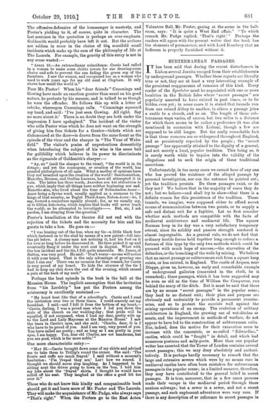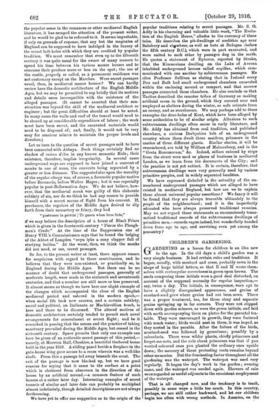SUBTERRANEAN PASSAGES.
IT has been said that during the recent disturbances in Lisbon several Jesuits escaped from their establishments by underground passages. Whether these reports are literally true or not, they are at least a very interesting example of the persistent reappearance of rumours of this kind. Every reader of the Spectator must be acquainted with one or more localities in the British Isles where "secret passages" are populai..4 asserted to have existed in past times, or to lie hidden even yet ; in some cases it is stated that tunnels run from one ruined Abbey to another, in others a passage joins a castle to a church, and so on. The length of these sub- terranean ways varies, of course, but two miles is a distance for which there seems to be rather a preference (it was also mentioned in connexion with Lisbon), though a few are supposed to be still longer. But the really remarkable fact is that these rumours are so widespread throughout England, and so persistently reported by the people ; the "secret passage" has apparently attained to the dignity of a general, and not merely a local, popular tradition. This being so, it is surely worth while to inquire into the validity of the allegations and to seek the origin of these traditional assertions.
Unfortunately, in too many cases we cannot hear of any one who has proved the existence of the alleged passage by personal investigation, nor can the entrance be pointed out; yet the tradition persists. Do these passages exist, or do they not ? We believe that in the majority of cases they do not ; but we believe—and shall try to show—that there is a definite reason for this persistence of the tradition. These tunnels, we imagine, were supposed either to afford secret means of communication between two points, or to supply a safe and distant exit for a fugitive. Let us first consider whether such methods are compatible with the facts of mediaeval architecture and mediaeval life. The square Norman keep in its day was a very satisfactory temporary retreat, since its solidity and passive strength rendered it almost impregnable. As a general rule, we do not find that ordinary hostile forces held together long enough to reduce a fortress of this type by the only two methods which could be pursued with much hope of success,—the starvation of the defenders, or the breaching of the walls by mining. We believe that no secret passage or subterranean exit from a square keep exists, or has existed, in England. The castle of Argues, near Dieppe, gives us, however, an early and remarkable example of underground galleries (excavated in the chalk, be it remarked) ; these passages, which it has been suggested may be even as old as the time of William the Conqueror, run behind the scarp of the ditch. But it must be said that these are by no means "secret passages" in the popular sense; they lead to no distant exit; their plan and purpose are obviously and undeniably to provide a permanent counter- mine, and so to protect the enceinte wall against the mining operations of an enemy. The evolution of military architecture in England, the growing use of wet-ditches or moats, and the improvement in methods of warfare, do not appear to have led, to the construction of subterranean exits. Nor, indeed, does the motive for their excavation seem to increase with the concentric, or so-called "Edwardian," castles, which could be " fought " in detail, and which had numerous posterns and sally-ports. More than one popular writer has asserted that the Tower of London contains several secret passages; this we may deny absolutely and authori- tatively. It is perhaps hardly necessary to remark that the large and extensive sewers which were by no means rare in mediaeval castles have often been mistaken for subterranean passages in the popular sense ; in a limited measure, therefore, they may have contributed to the general belief in secret passages. It is true, moreover, that in a few cases persons made their escape in the mediaeval period through these noxious subways ; but a sewer is a sewer, and not a secret passage, and such unpleasant adventures were very rare. If there is any description of or reference to secret passages in the popular sense in the romances or other mediaeval English literature, it has escaped the attention of the present writer, and he would be glad to be referred to it. It seems improbable, if only on grounds of expense, that any but the magnates of England can be supposed to have indulged in the luxury of the secret bolt-holes with which they are credited by popular tradition. We must remember that even up to the fifteenth century it was quite usual for the owner of many manors to spend his time between his various manor houses and to consume their produce more or less on the spot ; the use of the castle, properly so called, as a permanent residence was not customary except on the Marches. Were secret passages usual, then, in mediaeval manor houses ? We can hardly review here the domestic architecture of the English Middle Ages, but we may be permitted to say briefly that its motives and details seem incompatible with the existence of the alleged passages. (It cannot be asserted that their con- struction was beyond the skill of the mediaeval architect or engineer ; but the great difficulties should at least be noted. In many cases the walls and roof of the tunnel would need to be shored up at considerable expenditure of labour ; the work must have been secret, and the excavated materials would need to be disposed of; and, finally, it would not be very easy for amateur miners to maintain the proper levels and direction.) Let us turn to the question of secret passages said to have been connected with Abbeys. Such things certainly find no shadow of raison d'être in any known monastic Rule; their existence, therefore, implies irregularity. In several cases underground ways are supposed to have joined a convent of monks to one of nuns, the convents being separated by a greater or less distance. The suggested slur upon the morality of the regular clergy was, of course, a favourite popular motive before Boccaccio, before Walter Mapes ; but it was especially popular in post-Reformation days. We do not believe, how- ever, that the mediaeval monk was guilty of this elaborate subtlety of sin, nor do we think he had any reason to provide himself with a secret means of flight from his convent. If, perchance, the regulars of the Middle Ages desired to slip forth from their monastery or friary, they had
"posternes in privite / To paean when hem liste,"
if we may believe the description of a house of Black Friars which is given in the fourteenth-century "Pierce the Plough- man's Crede." At the time of the Suppression one of
Henry Commissioners says that he found the lodging of the Abbot of Langden "evyn lyke a cony clapper full of startyng hoilles." At the worst, then, we think the monks did not need, or use, secret passages.
So far, to the present writer at least, there appears reason for scepticism with regard to these contrivances, and he believes that they were non-existent, or practically so, in England during the Middle Ages. But there can be no manner of doubt that underground passages, generally of moderate length, were made in the sixteenth and seventeenth centuries, and that a number are still more or less preserved. It almost seems as though we have here one slight example of the changes which accompanied the close of the English mediaeval period and ushered in the modern epoch,— when social life took new courses, and a certain subtlety, moral and political, an Italianate or Machiavellian touch, is here and there to be discerned. The altered motives of domestic architecture certainly tended to permit such novel arrangements for concealment or secret flight ; and be it remarked in passing that the means and the practice of taking sanctuary prevailed during the Middle Ages, but ceased in the sixteenth century. Space permits that only one example can here be given of an authentic secret passage of this period,— namely, at Moreton Hall, Cheshire, a beautiful timbered house built in the year 1559. A sliding panel beside a fireplace in the gate-house wing gave access to a room wherein was a well-like shaft. From this a passage led away beneath the moat. The exit of the passage is now blocked up, but we have good reasons for saying that it came to the surface at a point which is sheltered from observers in the direction of the house by an artificial mound,—a common feature of such houses at a rather later day. Interesting examples of secret tunnels of similar and later date can probably be multiplied almost indefinitely, though detailed descriptions are not always forthcoming.
We have yet to offer our suggestion as to the origin of the
popular traditions relating to secret passages. Mr. S. 0. Addy in his charming and valuable little work, "The Evolu- tion of the English House," alludes to the currency of these tales. He describes the pit-dwellings of neolithic age near Salisbury and eleewhere, as well as huts at Bologna (before the fifth century B.C.), which were in part excavated, and were united to each other by passages dug in the earth. He quotes a statement of Ephoros, reported by Strabo, that the Kimmerians dwelling on the Lake of Avenue. inhabited underground houses called argillae, which com- municated with one another by subterranean passages. He cites Professor Sullivan as stating that in Ireland every Dun and Bath had small underground chambers excavated within the enclosing mound or rampart, and that narrow passages connected these chambers. He also reminds us that Tacitus described the remoter tribes of Germany as making artificial caves in the ground, which they covered over and employed as shelters during the winter, as safe retreats from an enemy, and as storehouses. We may perhaps add to these examples the dune-boles of Bent, which have been alleged by some authorities to be of similar origin. Allusions to such subterranean dwellings often occur in early literature, and Mr. Addy has obtained from oral tradition, and published elsewhere, a curious Derbyshire tale of an underground country where there dwelt three maidens, prisoners in the castles of three different giants. Similar stories, it will be remembered, are told by William of Mahnesbury, and in the " Geste Rornanorum," &a. Indeed, cellars entered by steps from the street were used as places of business in mediaeval London, as we learn from the documents of the City ; and the practice is not yet extinct. It is certain, therefore, that subterranean dwellings were very generally used by various primitive peoples, and in widely separated localities.
We have expressed disbelief in the actuality of the un- numbered underground passages which are alleged to have existed in mediaeval England, but how are we to explain these almost universal popular assertions ? We fancy it will be found that they are always traceable ultimately to the people of the neighbourhood ; and it is the imperfectly educated who have always preserved traditional remains. May we not regard these statements as unconsciously trans- mitted traditional records of the subterranean dwellings of primitive men,—records vague indeed, but wonderfully handed down from age to age, and surviving even yet among the peasantry ?















































 Previous page
Previous page